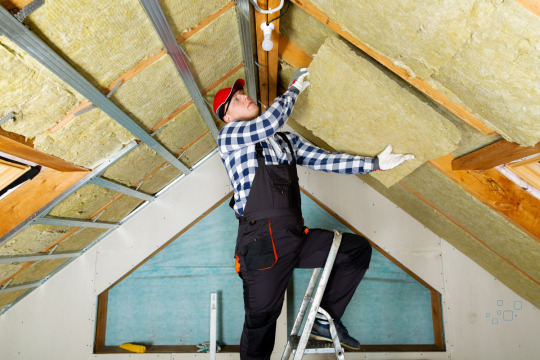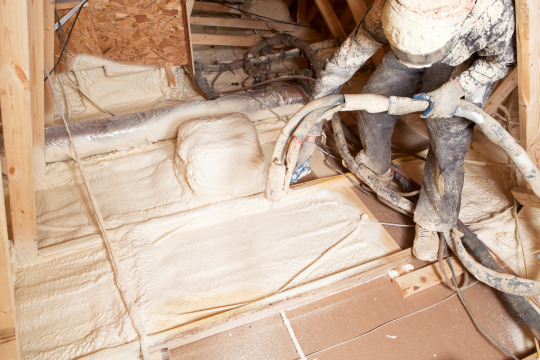Don't wanna be here? Send us removal request.
Text
How to Protect Your Home with Extreme Weather Insulation
Introduction
Extreme weather events—from heatwaves and blizzards to hurricanes and floods—are becoming more frequent. One of the best ways to weatherproof your home is through high-quality insulation. Proper insulation helps regulate indoor temperatures, reduce energy costs, and prevent structural damage caused by harsh weather conditions.
In this blog, we’ll cover why insulation is essential, the best types for different weather conditions, and how to reinforce your home for ultimate protection. If you're looking for expert Insulation Services near me, understanding these factors will help you make the best choice for your home’s efficiency and comfort.

1. The Role of Insulation in Extreme Weather
Insulation reduces heat transfer, keeping your home cool in summer and warm in winter. In extreme weather, insulation also: ✔ Protects against moisture damage from rain and snow ✔ Reduces energy consumption, lowering utility bills ✔ Enhances structural durability, especially in storms
💡 Did You Know? Poor insulation accounts for 40% of a home's energy loss!
2. Choosing the Right Insulation for Different Climates
A. Best Insulation for Cold Climates
For freezing temperatures, you need insulation that retains heat and prevents cold drafts.
✔ Spray Foam Insulation: Creates an airtight seal to prevent heat loss ✔ Fiberglass Batts: Affordable and effective for walls and attics ✔ Cellulose Insulation: Dense material ideal for preventing cold infiltration
💡 Pro Tip: Insulating windows and door frames helps block drafts.
B. Best Insulation for Hot & Humid Climates
In extreme heat, insulation should prevent heat absorption and keep your home cool.
✔ Radiant Barrier Insulation: Reflects heat away from the house ✔ Rigid Foam Board: High thermal resistance to reduce heat gain ✔ Blown-In Cellulose: Effective for attic insulation
💡 Best Practice: Use vented soffits and ridge vents to allow hot air to escape.
C. Best Insulation for Hurricane-Prone Areas
Homes in storm-prone regions need water-resistant and impact-resistant insulation.
✔ Closed-Cell Spray Foam: Strengthens walls and resists water damage ✔ Rigid Foam Board: Ideal for insulating basements and foundations ✔ Mineral Wool Insulation: Fire-resistant and does not absorb water
💡 Safety Tip: Reinforce garage doors and attic spaces to prevent storm damage.
3. Where to Insulate for Maximum Protection
A. Attic: The #1 Heat and Cold Barrier
Proper attic insulation reduces heat buildup in summer and retains warmth in winter.
B. Walls: Preventing Extreme Temperature Swings
Adding spray foam or rigid insulation can reduce heat loss by 35%.
C. Crawl Spaces & Basements: Flood & Moisture Protection
Uninsulated basements and crawl spaces allow cold air, heat, and moisture to enter. Waterproof insulation prevents mold and damage. In my previous blog, 'Spray Foam vs. Fiberglass: Which Insulation Should You Choose?', I explored the key differences between these two popular insulation options. If you’re interested in a detailed comparison, be sure to check it out!
4. Extra Weatherproofing Measures
✔ Use storm-resistant windows and doors ✔ Seal air leaks around vents and ducts ✔ Apply waterproof coatings on exterior walls ✔ Upgrade roofing materials for better insulation
Conclusion
Extreme weather demands strong home insulation. Whether you’re facing blistering summers, icy winters, or hurricane-force winds, choosing the right insulation enhances comfort, saves energy, and protects your home. Investing in proper insulation today means a safer, more efficient home for years to come.
0 notes
Text
Spray Foam vs. Fiberglass: Which Insulation Should You Choose?
Introduction
When improving your home's energy efficiency, the choice of insulation plays a vital role. Among the most common insulation materials are spray foam and fiberglass, each with its unique benefits and drawbacks. Whether you're building a new home or retrofitting an existing one, understanding the differences between spray foam and fiberglass insulation can help you make the right decision.

Let’s explore the key features, pros, and cons of both insulation types to guide you in making an informed choice.
1. Understanding Spray Foam Insulation
Spray foam insulation is a two-part liquid that expands into foam when sprayed into walls, floors, or ceilings. It forms a continuous barrier that fills gaps and cracks, providing superior insulation.
a. Types of Spray Foam
Open-Cell Foam: Lightweight and spongy, open-cell foam is used for interior applications and provides soundproofing in addition to insulation.
Closed-Cell Foam: More rigid and dense, closed-cell foam offers higher insulation values and also acts as a vapor barrier, making it ideal for areas prone to moisture.
Key Advantages of Spray Foam
Air Barrier: Spray foam provides an airtight seal that significantly reduces air leaks and drafts, improving energy efficiency.
High Insulation Value (R-Value): Spray foam has a high R-value, providing better thermal resistance than other types of insulation.
Moisture Control: Closed-cell spray foam acts as a moisture barrier, helping to prevent mold and mildew in areas with high humidity.
Durability: Once applied, spray foam insulation retains its shape and effectiveness for many years without degradation.
Drawbacks of Spray Foam
Cost: Spray foam is one of the most expensive insulation options available, particularly closed-cell foam.
Professional Installation Required: Due to the technical nature of the application, spray foam must be installed by a certified professional.
Chemical Off-Gassing: During installation, spray foam may release gases that require proper ventilation.
2. Understanding Fiberglass Insulation
Fiberglass insulation is a popular and widely used option due to its affordability and versatility. It consists of fine glass fibers that trap air pockets, slowing the transfer of heat.
a. Types of Fiberglass Insulation
Batt Insulation: Available in pre-cut panels, fiberglass batt insulation is used in walls, attics, and floors. It is one of the easiest types of insulation to install.
Loose-Fill Insulation: Blown-in fiberglass is used to fill attics and wall cavities. It is particularly useful for retrofitting existing homes.
Key Advantages of Fiberglass Insulation
Affordability: Fiberglass insulation is significantly cheaper than spray foam, making it a more accessible option for most homeowners.
Ease of Installation: Fiberglass is often a DIY-friendly option, especially in batt form.
Non-Combustible: Fiberglass does not catch fire, adding a layer of safety to your home.
Widely Available: Fiberglass is one of the most commonly available insulation materials, found in most home improvement stores.
Drawbacks of Fiberglass
Lower Insulation Value: Compared to spray foam, fiberglass has a lower R-value and may require thicker layers for adequate insulation.
Air Leaks: Fiberglass does not create an air barrier, which can allow drafts and reduce energy efficiency.
Moisture Vulnerability: When fiberglass insulation gets wet, it loses much of its insulating ability and can harbor mold.
3. Energy Efficiency Comparison: Spray Foam vs. Fiberglass
When considering energy efficiency, spray foam takes the lead. Its ability to seal cracks and prevent air leaks helps reduce the workload on your heating and cooling systems, leading to lower energy bills. Additionally, its higher R-value makes it more effective in both hot and cold climates.
Fiberglass insulation, while effective, does not offer the same air-sealing properties. Although it slows down heat transfer, the presence of gaps can still allow air to escape, reducing its overall efficiency. However, with proper installation and sufficient thickness, fiberglass can still provide a reasonable level of insulation.
4. Cost Comparison: Spray Foam vs. Fiberglass
Cost is a significant factor when deciding between these two insulation types. Spray foam is notably more expensive, both in terms of material and installation costs. However, the energy savings from reduced air leakage can offset the initial investment over time, making spray foam a long-term cost-effective option.
Fiberglass is far more affordable upfront, making it ideal for budget-conscious homeowners. Installation costs are lower, and in some cases, you can install it yourself, further reducing expenses. However, due to its lower energy efficiency, the savings on utility bills may not be as significant as with spray foam.
5. Application and Installation Considerations
Spray foam is ideal for areas that require airtight seals, such as attics, crawl spaces, and basements. Its ability to conform to irregular surfaces also makes it a good choice for homes with unique architectural features. Since professional installation is required, it ensures the foam is applied correctly for maximum effectiveness.
Fiberglass, on the other hand, is commonly used in walls, floors, and ceilings. It’s relatively easy to install, especially in batt form, making it suitable for DIY projects. However, it must be installed carefully to avoid gaps or compression, which can reduce its insulating effectiveness.
6. Durability and Longevity: Spray Foam vs. Fiberglass
Spray foam insulation offers long-lasting performance. Once applied, it maintains its shape and does not settle, compress, or degrade over time. This durability makes it a low-maintenance option that can provide insulation for decades.
Fiberglass insulation, especially loose-fill varieties, may settle over time, leading to reduced performance. It can also become damaged if exposed to moisture or pests. As a result, it may require periodic maintenance or replacement to maintain optimal insulation levels.
7. Choosing the Right Insulation for Your Home
Ultimately, the choice between spray foam and fiberglass depends on your specific needs. If energy efficiency, airtightness, and long-term savings are your top priorities, spray foam is likely the better option. While it comes with a higher upfront cost, its superior performance can lead to significant savings on energy bills.
If you’re working with a tighter budget and need a more affordable solution, fiberglass insulation is a practical choice. It provides decent insulation and can be installed relatively easily, making it a good option for those looking to insulate large areas without breaking the bank.
Conclusion: Making the Right Choice
Both spray foam and fiberglass insulation offer distinct advantages. Spray foam is ideal for homeowners seeking the best energy efficiency, airtightness, and durability, while fiberglass is a cost-effective and versatile option suitable for most homes. When choosing insulation, consider your budget, climate, and long-term energy-saving goals to make the best decision for your home.
1 note
·
View note